Serving as a space to envision both resistance and empowerment, Indigenous Futurism(s) is a field that works to affirm the presence and identity of Indigenous communities and individuals in the past, present and future. While exploring future or alternative worlds in which the history and past experiences of Indigenous communities directly inform the empowerment and survivance of Indigenous peoples both presently and in the future, Futurism(s) allows the correction or destruction of our world that works to exclude the lived experiences of Indigenous individuals and communities in lieu of a multitude of worlds in which such experiences are affirmed as integral. By using such genres as Science Fiction, Fantasy, Horror, and Cyberpunk as a platform, genres which possess precedence in excluding the influence and presence of Indigenous voices, these Indigenous authors and creators work to affirm Indigenous sovereignty through self-determined work and collaboration. The items in this display feature strong Indigenous protagonists that, unlike their genre predecessors that often perpetuate colonial fantasy, do not treat the advancement of technology or the discovery of new worlds and Indigenous science, culture and spirituality as antipathetic, but rather as fundamentally complimentary.
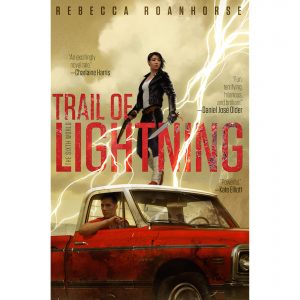 The first book of The Sixth World, a series that features a strong Indigenous female as its lead, Trail of Lightning follows Maggie Hoskie as she journeys the post-apocalyptic world in which she and the remaining human race survives. After the rising waters borne from the climate apocalypse wash away most of the human race, the Gods, heroes, and monsters of Dinétah wash up on what was formerly the Navajo reservation and walk the land once more. With the help of the medicine man Kai Arviso, Maggie puts her extraordinary monster-killing gifts to the test in order to save the life of a missing young girl and unravel the secrets of the reservation’s ancient past. Soon, Maggie realizes that such a discovery relies on her ability to confront her own past—perhaps the biggest challenge of all.
The first book of The Sixth World, a series that features a strong Indigenous female as its lead, Trail of Lightning follows Maggie Hoskie as she journeys the post-apocalyptic world in which she and the remaining human race survives. After the rising waters borne from the climate apocalypse wash away most of the human race, the Gods, heroes, and monsters of Dinétah wash up on what was formerly the Navajo reservation and walk the land once more. With the help of the medicine man Kai Arviso, Maggie puts her extraordinary monster-killing gifts to the test in order to save the life of a missing young girl and unravel the secrets of the reservation’s ancient past. Soon, Maggie realizes that such a discovery relies on her ability to confront her own past—perhaps the biggest challenge of all.
A great read for lovers of Horror, Wrist by Nathan Niigan Noodin Adler is a thrilling novel 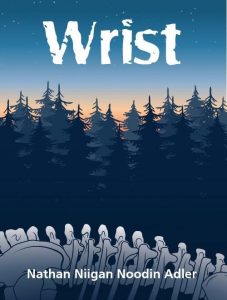 that combines the themes of Indigenous legend, cultural exploitation and science. Wrist follows the happenings of Church, an Anishinaabe boy who, along with his family, are descendants of the Anishinaabe monster Wiindigo. Plagued by an insatiable desire for human flesh, Church learns to control his cannibalistic desires in order to hide his true genetic and biological qualities. Pursued by monsters of other dimensions who desire the land that he has inherited, and plagued by the loneliness he experiences within his dysfunctional family, Church is forced to constantly battle the by-products of political, geographic and cellular colonization. Adler has created a poignant story that explores the battle between familial trauma and the hunger for peace.
that combines the themes of Indigenous legend, cultural exploitation and science. Wrist follows the happenings of Church, an Anishinaabe boy who, along with his family, are descendants of the Anishinaabe monster Wiindigo. Plagued by an insatiable desire for human flesh, Church learns to control his cannibalistic desires in order to hide his true genetic and biological qualities. Pursued by monsters of other dimensions who desire the land that he has inherited, and plagued by the loneliness he experiences within his dysfunctional family, Church is forced to constantly battle the by-products of political, geographic and cellular colonization. Adler has created a poignant story that explores the battle between familial trauma and the hunger for peace.
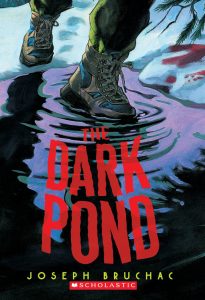 Another item that features the allure of other-worldly beings, The Dark Pond by Joseph Bruchac follows Armie, a sixteen-year-old boy who’s Armenian and Shawnee heritage make him feel like an outcast. When Armie’s parents send him to a new school, he soon discovers a dark pond in the forest from which no animals ever return. Sure that there is something more to this seemingly sinister pond and determined to uncover what lies beneath, Armie turns to the teachings of his Shawnee ancestors for help. Positing the Shawnee ancestral teachings as pinnacle to the survival of its main protagonist, The Dark Pond is an important text that illustrates the significance of Indigenous knowledge.
Another item that features the allure of other-worldly beings, The Dark Pond by Joseph Bruchac follows Armie, a sixteen-year-old boy who’s Armenian and Shawnee heritage make him feel like an outcast. When Armie’s parents send him to a new school, he soon discovers a dark pond in the forest from which no animals ever return. Sure that there is something more to this seemingly sinister pond and determined to uncover what lies beneath, Armie turns to the teachings of his Shawnee ancestors for help. Positing the Shawnee ancestral teachings as pinnacle to the survival of its main protagonist, The Dark Pond is an important text that illustrates the significance of Indigenous knowledge.
Following the reluctant hero Frenchie, The Marrow Thieves by Cherie Dimaline takes 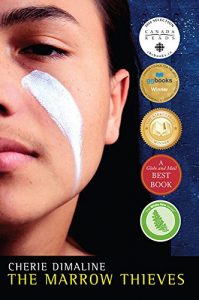 place in a dystopian world where most of the surviving population risks being driven mad by their newfound inability to dream. Unaffected by this phenomenon, however, are the Indigenous people of North America whose ability to dream is “woven into their bone marrow.” Desperate to harvest and harness this genetic ability to dream, the Canadian government create the Department of Oneirology, whose recruiters’ sole purpose is to catch and bring Indigenous people to “factories”—factories which evoke the image of Residential Schools—in order to steal their marrow and thus kill them in the process. While following the story of Frenchie and his makeshift family, made up of eight other Indigenous nomads attempting to survive and reunite with their loved ones, Dimaline weaves a tale of a resistance and survivance reliant on the perseverance and strength of Indigenous community.
place in a dystopian world where most of the surviving population risks being driven mad by their newfound inability to dream. Unaffected by this phenomenon, however, are the Indigenous people of North America whose ability to dream is “woven into their bone marrow.” Desperate to harvest and harness this genetic ability to dream, the Canadian government create the Department of Oneirology, whose recruiters’ sole purpose is to catch and bring Indigenous people to “factories”—factories which evoke the image of Residential Schools—in order to steal their marrow and thus kill them in the process. While following the story of Frenchie and his makeshift family, made up of eight other Indigenous nomads attempting to survive and reunite with their loved ones, Dimaline weaves a tale of a resistance and survivance reliant on the perseverance and strength of Indigenous community.
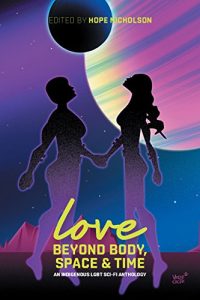 Love beyond Body, Space and Time is an anthology of Indigenous Science Fiction and Urban Fantasy focused on LGTBQ+ and two-spirit characters. While featuring stories of love, self-love, hardship, and perseverance, this item works to give power to voices who experience discrimination and prejudice on an intersectional level. From the story of a transgender women taking experimental transition medicine to one of two lovers finding each other across all boundaries and scopes of time, this item is a truly beautiful and genuine expression of love that is unconditional, uncontainable, and true. With its contributors including authors like Grace Dillon, Gwen Benaway and Cherie Dimaline, Love beyond Body, Space, and Time gives the stage to those whose stories have gone unrecognized for far too long.
Love beyond Body, Space and Time is an anthology of Indigenous Science Fiction and Urban Fantasy focused on LGTBQ+ and two-spirit characters. While featuring stories of love, self-love, hardship, and perseverance, this item works to give power to voices who experience discrimination and prejudice on an intersectional level. From the story of a transgender women taking experimental transition medicine to one of two lovers finding each other across all boundaries and scopes of time, this item is a truly beautiful and genuine expression of love that is unconditional, uncontainable, and true. With its contributors including authors like Grace Dillon, Gwen Benaway and Cherie Dimaline, Love beyond Body, Space, and Time gives the stage to those whose stories have gone unrecognized for far too long.
For these and more books on Indigenous Resistance and Futurism(s), visit the Lobby Display on the ground floor of OISE Library. Please feel free to take out the materials found in the Display.
